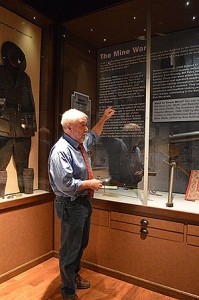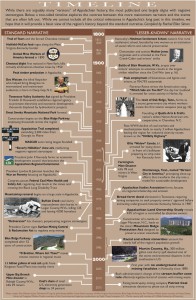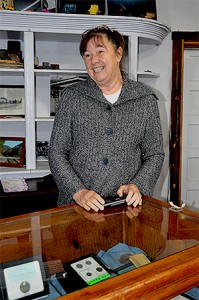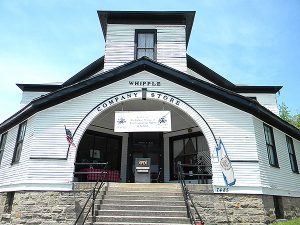AV's Intern Team | October 9, 2013 | 6 Comments
By Bill Kovarik
It has been 50 years since Harry Caudill wrote “Night Comes to the Cumberlands,” a landmark history that rejected stereotypes of Appalachian people as backward hillbillies and described the ruthless exploitation they suffered. The book spoke with eloquence to the American conscience and set off a firestorm of controversy. Within a year, Lyndon Johnson would launch his “war on poverty” from the front porch of an Appalachian cabin.

Labor historian Wess Harris, editor of “When Miners March”- a book about the 1921 battle over labor rights on Blair Mountain – points out flaws in the West Virginia state exhibit on the early 20th century mine wars in central Appalachia during one of his “truth tours” of the museum. Photo by Linda Burton
Coming in the middle of the civil rights movement, Caudill’s book also launched some serious soul-searching about poverty, national sacrifice zones and the worth of people who were in the way of corporations.
Since then, great books about Appalachian history and culture have filled library shelves with descriptions of the suffering poor, the arrogant rich, and the extraordinary cruelty of mining society in the early 20th century.
Not surprisingly, you also find people fighting back all throughout this history — from the Cabin Creek strike of 1912 to the Battle of Blair Mountain in 1921 to the wildcat 1969 black lung strike, and in the environmental protests of the past four decades against strip mining and then mountaintop removal coal mining. There is, in this, a complete and unbroken fabric of human spirit, fighting in support of mine safety, public health and environmental protection.
Why, then, do critics like Wess Harris say we have such poor public history in West Virginia’s state museum, and why does the state of West Virginia refuse to help protect the Blair Mountain Battlefield?
Perhaps the encouraging part is that history does still matter — for all of us. It matters to educators and to the coal industry and its friends. But it also matters to people in labor and environmental movements. There may be several interpretations of history, but very few people would disagree that basic documents and battlegrounds should be preserved. State institutions nearly always approach this obligation with at least some degree of neutrality – except West Virginia.
What’s different today is that the Rust Belt industries are no longer in a position to control their historical messages. The industry that once held the state of West Virginia tightly in its fist is now rapidly losing its grasp.
It’s a moment when history is needed.
Labor historian Wess Harris begins his “truth tours” on the steps of the West Virginia State Museum by telling students: “Welcome to our house.” History belongs to the people, he says, not to the corporations. And he tells them to be wary — there are some squatters from the coal companies inside.
With this somewhat tongue-in-cheek approach, Harris has taken about a thousand students and scholars on his personalized truth tours through the museum in downtown Charleston, W.Va. Tours are free, and Harris has encouraged museum officials to join him. So far, none have.
“You know the idea that if you control people’s past, you can control their future? That’s what this is all about,” he says.
A labor historian and editor of two best-selling books about West Virginia — “When Miners March” and “Dead Ringers” — Harris has been particularly concerned about the company store and mine war exhibits.
The re-creation of the old coal company store involves a counter, a cash register and canned goods from the time, framed by a long description of the role of the company store in the center of a mine community’s life. The stores used to pay miners in “scrip,” which was money that could only be spent at the company store. A song about that by Tennessee Ernie Ford — “I owe my soul to the company store,” —is still widely known. Historians are working out just how deeply and dangerously a miner could go into debt, thanks to the recovery of company store records in Whipple, W.Va.
But at the West Virginia museum, the store is easy to explain: “Like credit cards, scrip allowed some families to fall deeply into debt. Others, however, enjoyed the freedom to purchase expensive items, like washing machines…”
When he learned of the museum’s altered history, Harris was outraged, and he wrote the head of the state museum, Randall Reid-Smith, in 2010. “The treatment of scrip as some sort of favor to the miners is an insult to the people of our state,” Harris wrote.
When the state museum responded by saying his criticism was inaccurate, the head of the United Mine Workers of America, Cecil Roberts, joined Harris in demanding a reconsideration of the exhibit.
“Your presentation makes it seem as if the scrip system was little different from a credit card, where miners and their families could pay off expensive purchases over time,” Roberts wrote. “Nowhere [in the exhibit] is it stated that miners had absolutely no choice as to whether they used scrip or not. Nowhere is it mentioned that going somewhere else instead of the company store to purchase goods and equipment was an offense frequently punishable by a beating from the company’s Baldwin-Felts thugs followed by dismissal from employment and eviction from the company house.”
Roberts was also ignored until he wrote West Virginia Gov. Earl Ray Tomblin, who — in the middle of an election campaign in 2011 — ordered the state museum to review the exhibit. They did, and a few words were changed: “Company-issued scrip forced some families deep in debt and gave many companies strict economic control over the lives of their workers. In some communities, however, families were able to purchase expensive items, like washing machines…”
The changes in the exhibits did not pacify the UMWA. “They made some minor modifications to some of the exhibits,” said spokesman Phil Smith in September 2013. “But we still have concerns.”
Other critics also still have concerns. “I remember specific conversations about the need for [the West Virginia] museum to include more bottom-up history, more labor history, and more about the 1960s and the war on poverty,” says Ron Eller of the University of Kentucky. “I remember specifically pointing out that the museum should not just reflect the usual pro-coal, pro-development history of the state but that it should also reflect the history of labor struggles, resistance to environmental destruction, and efforts to address economic challenges, especially poverty, in the state.”

A two-sided timeline of Appalachian history reveals an interesting contrast between events that are well-known and events that are sometimes forgotten.
It’s easy to see why labor historians are unhappy with the West Virginia State Museum, with exhibits like “U.S. Army Stops Armed Insurrection in West Virginia” and “The Failure of Violence.”
The first is presented in silent movie newsreel fashion in a small mock-up theater. Most of the visuals include miners with guns on one side and U.S. Army troops on the other.
Titles in the silent movie read:
“Over the last year, a near-constant state of war has existed between miners and coal companies. Armed troops have been dispatched repeatedly to quell the bloodshed. The recent flare-up has been sparked by the cold-blooded murder of Matewan police chief Smiling Sid Hatfield — a popular friend of the miner. They are stopped at Blair Mountain by Logan County sheriff Don Chafin and a small army of deputies. The miners and Chafin’s army shoot it out for three days along a 10-mile front. Sixteen men are killed. President Harding dispatches U.S. Army infantry …. The miners, many of them veterans of the Great War, surrender rather than confront their former comrades in arms. Some union leaders are placed under arrest for treason and murder. Most miners are allowed to board trains and return to their families. Thus ends the Battle of Blair Mountain, the largest insurrection since the Civil War.”
According to Harris, the entire basis of the exhibit is inaccurate. The union actually tried to call off the march on Blair Mountain in 1921. The Army was called in to separate the miners from the mine guards. Nor does the exhibit present any context for the march, other than the cold-blooded murder by some unnamed individual. No one would know that the murderers were coal mine guards whose co-workers and bosses were on the other side at Blair Mountain. And if the museum is going to say that the union leaders were charged with treason, it ought to add that they were acquitted, Harris says.
There’s another panel about the Battle of Blair Mountain called: “The Failure of Violence.” The exhibit claimed — falsely — that in 1921, union organizers turned to violence so that they could get more union members.
“Ten thousand citizens take up arms (in 1921) to end the slave labor camps … and they call it a failure?” Harris says. “It was a serious challenge to the old system. It was no failure.”
But at the very least, the exhibit notes that the Battle of Blair Mountain was the “largest insurrection since the U.S. Civil War.” Given that, it’s hard to understand the role of the West Virginia Division of Culture and History in challenging historical protection for the Blair Mountain battlefield.
Blair Mountain is the labor movement’s equivalent of the Gettysburg battlefield. The idea of preserving Blair Mountain has been around for decades, but an on-the-ground history of the battlefield in the 1990s and 2000s helped make the case.

Over the last 15 years, Harvard Ayers (one of the founders of Appalachian Voices), along with historian Barbara Rasmussen and Blair, W.Va., resident Kenny King, performed formal archaeological surveys of the battlefield and found tens of thousands of bullets and other artifacts. Through the pattern of discoveries, they were able to trace shifting battle lines and show where both mine guards and miners were located.
This evidence helped make the case for a National Historic Landmark designation that, they hoped, would preserve the mountain from mountaintop removal coal mining. Their evidence was impressive enough that the U.S. National Park Service granted the site historic register status in March 2009, a move supported by the UMWA and a variety of environmental and historical preservation groups.
But the listing immediately led to an unprecedented controversy. According to law, a state has to want the designation, and a few months after it was granted, the West Virginia Division of Culture and History wrote to the Park Service asking that the battlefield be de-listed. The state office said it found minor problems with the listing, such as a handful of landowners who had not voted for or against the listing.
Park Service officials then agreed to de-list the site in January of 2010, taking a step that is usually reserved for situations when historic buildings have burned down. No other de-listing has ever taken place for such political reasons, and no explanation was ever forthcoming from the Park Service, which has maintained a stony silence about the incident.
A lawsuit challenging the de-listing was filed by a coalition of environmental and preservation groups in 2010. A court ruled against the coalition in 2012 on a technicality having to do with questions of standing. In the summer of 2013, the U.S. Army Corps of Engineers announced it would review mining permit applications.
This could mean that the coal industry will be allowed to destroy Blair Mountain. Or, since the Corps of Engineers is supposed to consider the historic value of land to be mined, it could mean more time for Blair Mountain and preservationists who are seeking a reprieve.

Joy Lynn pictured with a display case of “scrip,” a form of money paid to miners which could only be used in the store. Photo by Linda Burton
One of West Virginia’s innovative new historians is Joy Lynn, who grew up near the town of Whipple, W.Va. As a child, she was fascinated by an enormous, rambling old wood frame building that seemed to glow with history. “I’m going to own that someday,” she told her father back in the 1950s.
The dream came true in 2006, when she and husband Chuck bought the Whipple Company Store and prepared to open an antique shop. As neighbors dropped by and the word got out, people began touring the old company store, and they started telling stories. Lynn was hooked.
One of the most interesting people to show up at the company store was the former bookkeeper who explained, in detail, how the system of company money — called scrip — and indebtedness actually worked.
Over the years, dozens of others showed up with very human and often harrowing stories to tell. It was not possible to leave town, or to retrieve items from the mail, if you owed the coal company any money, Lynn learned from her visitors. On the other hand, if a husband died, it was not possible for the family to stay unless the mother remarried. She had four weeks, and then the mine guards would evict her and the children.

At the Whipple County Store and Appalachian Heritage Museum, Joy Lynn gathers stories from families with personal connections to the region’s coal history.
The people who experienced this, or sometimes their children, show up almost every day. “Sometimes they just unglue,” Lynn says. One told her: “I realize what you’re doing. You’re letting people find closure in their life.”
Lynn will insist that she’s just a tour guide. But her visitors say something else. “When I came up on this porch you were just a tour guide,” said one. “Now I just want to know if I can hug you.”
Mountain history is alive and well, thanks to historians like Dave Tabler. His blog — AppalachianHistory.net — hosts more than 1,300 entries and hundreds of podcasts on topics ranging from mountain music to labor history to personal experiences. “I want to share with my readers and listeners the idea that history is a living thing, a deep reservoir from which to nourish today’s culture, a tool to shape our current notions of what our heritage is and therefore what to do next to preserve and extend it,” Tabler says. Read the full story at appvoices.org/thevoice/podcasts
Like this content? Subscribe to The Voice email digests
Thank you for your generous appraisal of my site & podcasts. It’s an honor to be recognized in this company. I did notice the link appvoices.org/thevoice/podcasts isn’t live.
Fantastic article, and thanks so much for covering both the past and present Battles of Blair Mountain. For more information on the people’s history of the region, please do check out Wess Harris’s mentioned book with William C. Blizzard, When Miners March. You can take a look inside the book here:
https://secure.pmpress.org/index.php?l=product_detail&p=262
Our audiodrama ‘When Miners March – The Battle of Blair Mountain’ (William C. Blizzard) has consistently ranked high on audiobook lists and has several top reviews. Our accompanying music soundtrack of great coal mining songs by some famous Appalachians has also won us a large following. My thanks to Bill and Wess for the opportunity to produce such an important story and to contribute my on camera work for The History Channel’s ‘Hillbilly – The Real Story’. Ross… a son of Blair Mountain.
Many thanks to Bill Kovarik and Appalachian Voice for exposing the fiasco that is the West Virginia State Museum. Ron Eller, touted as one of the official State Museum Historians, recently reflected, “Today, I consider this entire episode as a sad reflection of the continuing power of the coal industry in West Virginia.”
Shining light on the mess is necessary but not sufficient. We must make it ever so clear that telling lies to the youth of West Virginia(or anywhere!) is not acceptable. Randall Reid-Smith, Kay Goodwin, and no few others owe the people of our state and our region both apologies and resignations. Time for them to do the right thing.
To clarify Wess’ comment about Ms. Goodwin, according to WV state code our State Historic Preservation Officer, Randall Reid-Smith, serves under the Cabinet Secretary of the WV Department of Education, Kay Goodwin. Together Goodwin and Reid-Smith have done more to ether downplay or destroy our proud labor history than almost any who have served before them.
I personally don’t understand why WV’s AFL-CIO and the UMWA doesn’t throw up a united picket line around the WV Culture & “History” Center at the state capitol until they, along with President of the WV State Board of Education Gayle Manchin, are all forced out office.
My grandfather , Frank Taulbee, came to Kenmont Coal Camp in 1915. He worked for Ken Mont Coal Company from 1915 until he retired in 1950. He raised five children in the Coal Camp. He and his family enjoyed living in Ken Mont Coal Camp. Perhaps Kenmont was an exception but Papaw or Dad who also was a Kenmont coal miner never felt that they were exploited or treated unfailrly by the company. Papaw was from Breathitt County Kentucky. Kenmont Coal Camp was at Jeff, Kentucky in Parry County. I think that many people find it to their benefit to exploit the Appalachian Stereotype. Tell the whole and complete story and we find Appalachians pretty much like their fellow Americans.